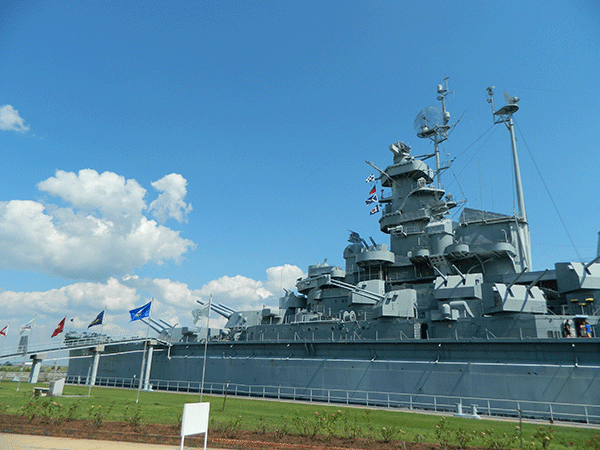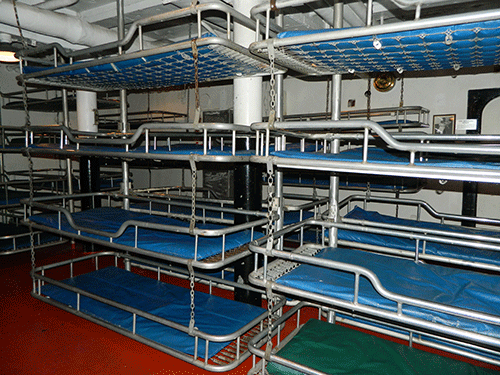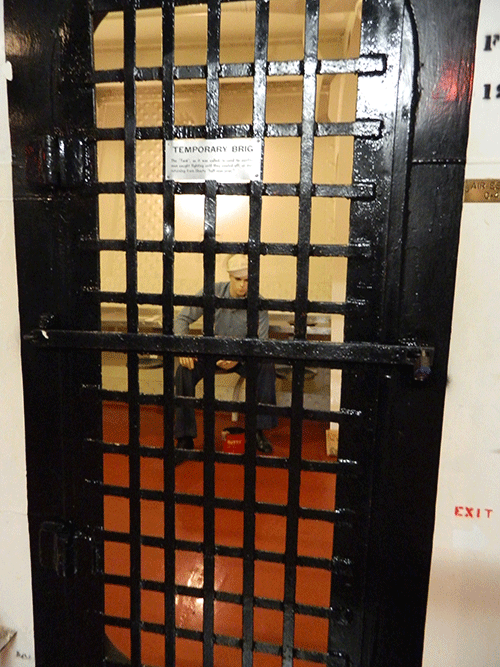By Shannon Clinton

Footsteps echo on metal floors as tinny Big Band-era music filters through a PA system on the USS Alabama in Mobile Bay, a massive floating time capsule paying tribute to the ship’s crew and wartime achievements.
Serving mainly in the South Pacific, the Navy battleship carried 2,500 crew members when it was commissioned in 1942, and saw 37 months of active duty in World War II, park Marketing Director Karen Conner says. Though there was no loss of life from enemy fire and no significant damage sustained, the ship earned nine battle stars on the Asiatic-Pacific Service Medal, as its crew shot down 22 planes.
The battleship was decommissioned and “mothballed” in 1947 in Washington State for many years, but with $100,000 raised from change collected by Alabama school children and another $1 million in corporate funds, the ship was saved from the scrapyard and was opened to the public in January 1965. The park is overseen by an independent government agency with a board of commissioners and is owned by the state of Alabama.
Offering seven upper and four lower levels of the 680-foot-long battleship to explore along with its original main deck, the park also includes the Medal of Honor Aircraft Pavilion that opened in the 1990s, and the oldest submarine on public display in the country, the USS Drum, which arrived on site in 1969.

The goal of the aircraft museum is to showcase aircraft spanning many decades in all branches of the nation’s military, Conner adds, and Korean and Vietnam War memorials are also on site in the park. A memorial to Operation Enduring Freedom is in the works to honor those who have served in Iraq and Afghanistan.
There’s also a theater on board the USS Alabama showing a 15-minute film that details former crew members’ accounts of daily life. Crew members assemble each year for reunions, and the ship is also made available to scouting groups for overnight stays, as well as for dinners, conventions and other special events.
In different tour routes, the park’s daily visitors learn what life was like for those serving on the USS Alabama, how it operated and about its weaponry, Conner says. All tours are self-guided and take about 2 1/2 hours total to complete.
On the Red Tour, for example, visitors will see a lathe and tool shop, sleeping areas with metal bunks and thin mattresses suspended from the ceiling, a small store, a soda fountain, and the ship’s kitchen, where about 7,500 meals a day were prepared. The average age of crew members was only 21 at the time, Conner says, and for the unruliest of the bunch, long hours of confinement in the temporary brig awaited.
“They literally slept where they worked,” Conner says. “It’s literally a floating city – they could even perform minor surgeries on the ship. It’s just amazing!”

One crew member was Bob Miller, a Selma native who now lives in Summerdale, Ala., and was on board the USS Alabama from Jan. 1944 to Oct. 1945 as an 18-year-old private first class in the U.S. Marine Corps. Miller, now 89, explained that Marine detachments were assigned “sea duty” on battleships, large cruisers and aircraft carriers for added security and to operate anti-aircraft weapons.
The USS Alabama’s role was to move quickly throughout the South Pacific attacking enemy strongholds and joining with other battleships, cruisers and destroyers to bombard targeted islands in the South Pacific, while providing cover to invading forces, he says.
Miller said the cramped conditions created camaraderie.
“On that ship, 600 Navy feet long and 180 feet wide, there were 2,500 men stationed and if you couldn’t get along you were in dire straits,” he says. “You absolutely learned how to get along with your fellow man in those close quarters. You can’t tell from the arrangements today how close those quarters were.”
And with steamy tropical temperatures to contend with and no air conditioning, “It was some pretty tough living,” Miller says. “The food was pretty good. We had dehydrated eggs, dehydrated potatoes and we had Australian mutton, but then at times when they could get some supply ships to us, the food was pretty good.”
Miller attends annual reunions of USS Alabama crew members, and has made it to all but the most recent one.
Conner said the ship’s curators have done their best to recreate true-to-life experiences for the more than 13 million visitors who have come on board since its opening.
“It definitely is a touch, feel, smell, really to ‘take you back’ facility,” she says. “…They really do come off the ship with a great experience of that World War II generation.”
Battleship Memorial Park and the USS Alabama are located at 2703 Battleship Parkway in Mobile, off I-10 exits 27 and 30. Admission is $15 ages 12 and up, $6 ages 6-11, under 6 free, $13 for seniors 55 and up, $13 for AAA members, free to active duty military and retired military with ID verification, $13 for active duty dependents 12 and up and $5 for active duty dependents ages 6-11. Parking is $2 per vehicle.
The park is open every day except Christmas Day from 8 a.m. to 6 p.m. April through September and 8 a.m. to 5 p.m. October through March. For more information call 251-433-2703 or visit the park’s website at www.ussalabama.com.
Honoring veterans
On Monday, Nov. 11, the Mobile Area Veterans Day Commission will host the following events:
10 a.m. – Veterans Day Parade – Downtown Mobile
11:30 a.m. – Veteran & Patriot of the Year Luncheon – Ft. Whiting – Ticket Event
3 p.m. – Veterans Day Observance Ceremony featuring area fourth graders leading the event with a Parade of Flags at the Aircraft Pavilion at USS ALABAMA Battleship Memorial Park. Free.
7 p.m. – Patriotic Concert by the Mobile Area Symphonic Pops Band at the Aircraft Pavilion at USS ALABAMA Battleship Memorial Park. Free.




